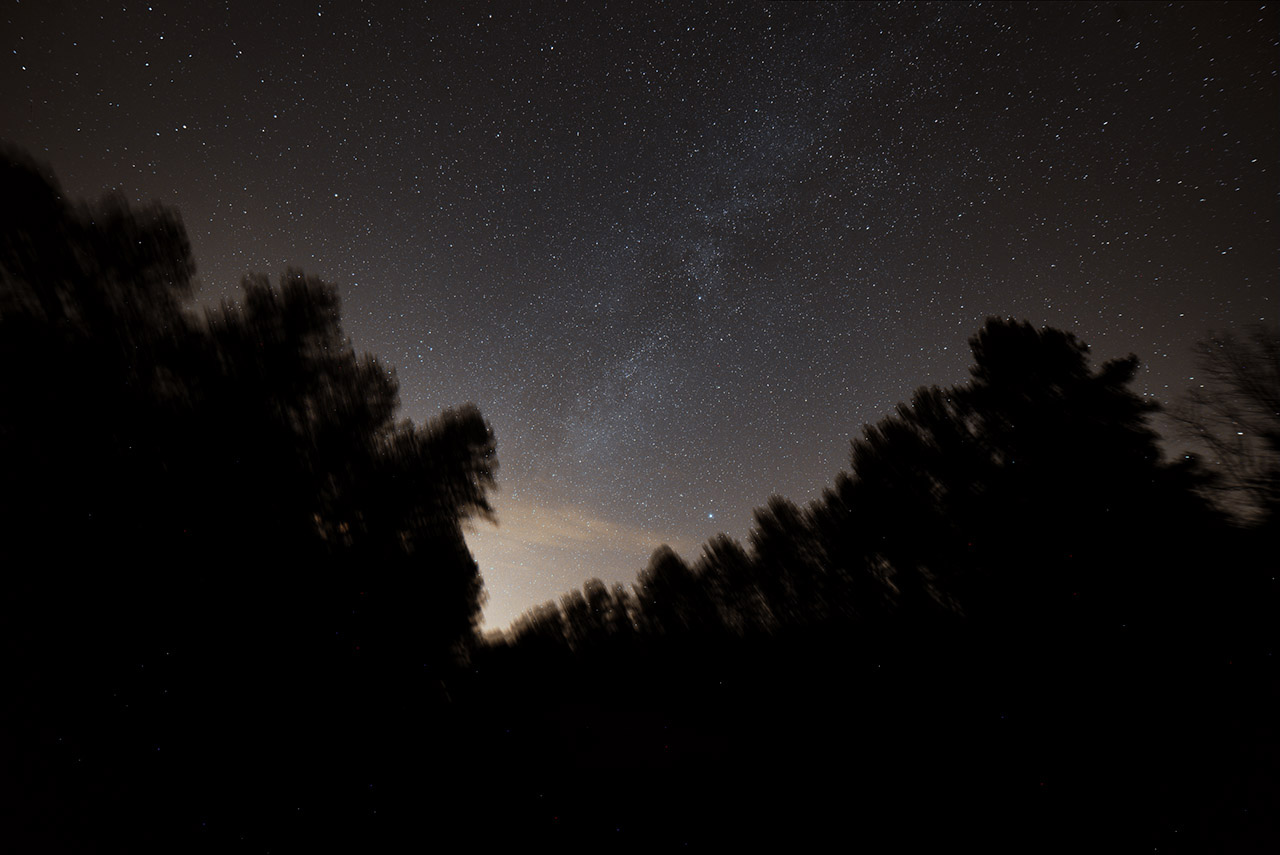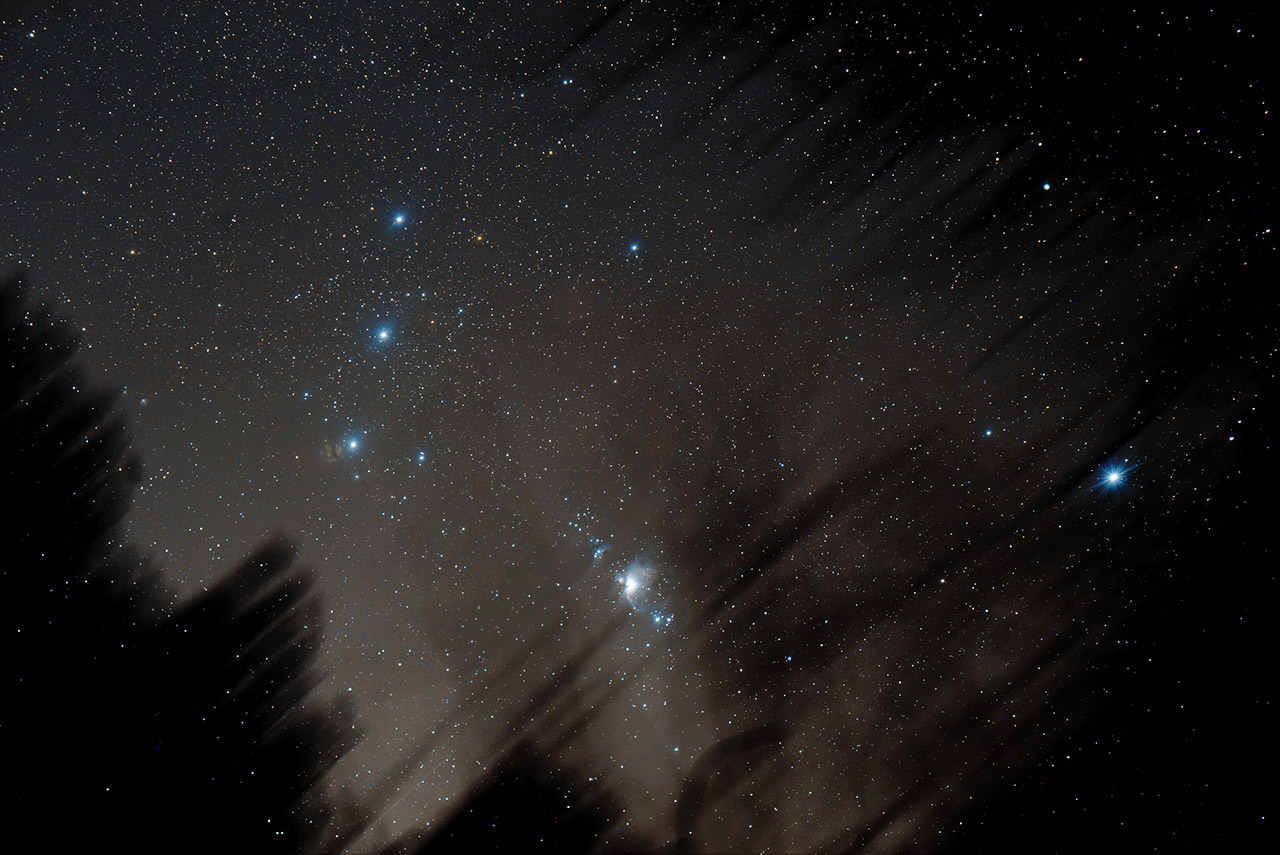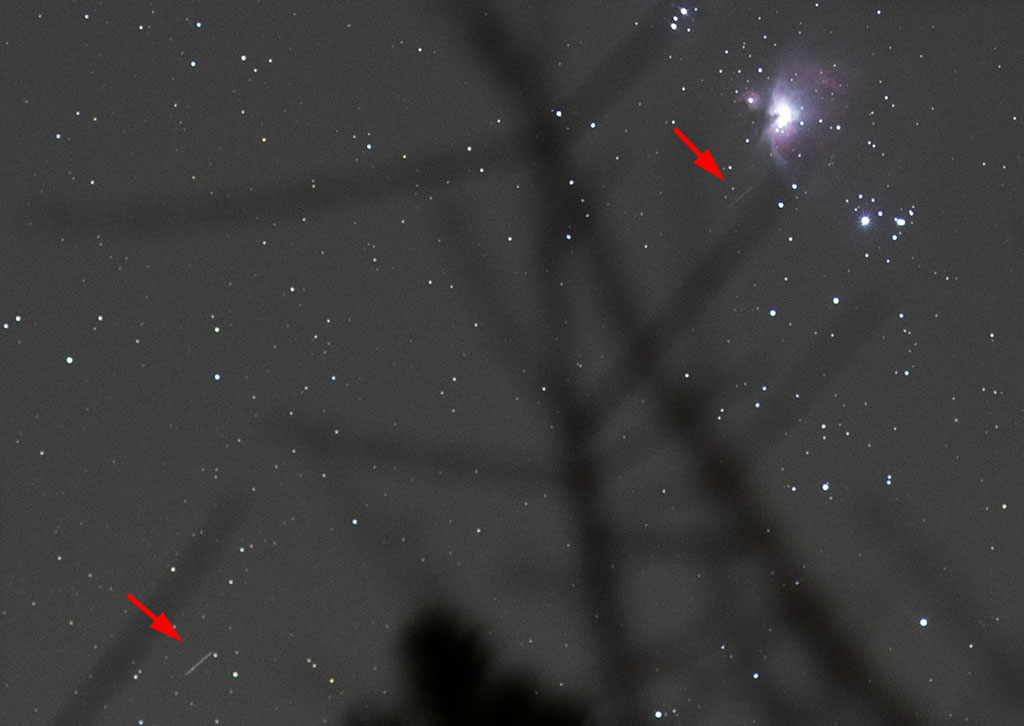11/30/2014. "Play a little with extreme ISO's," I said on the previous page and then remembered I had some four second (!) snapshots of the Milky Way from Doughton Park. They were only (!) ISO 6400, but they're something to start with. Take some data and work the numbers and see how tall stacks of silly-high ISO frames compare to shorter stacks of sane ones (equivalent exposures consisting of 64 subs at ISO 12800 vs fewer, longer subs at ISO 1600, for example; try it with and without calibration frames, with and without tracking). Here, for drill, is a stack of ten, 4-second untracked exposures from last July. The clouds are lit by North Wilkesboro, about 17 miles away:
.

Milky Way from
Doughton State Park
24mm F1.4 Rokinon / Canon 6D
10x4s ISO 6400, stationary tripod.
No calibration frames.
.
Focus was a whisker off, not that you can tell it from a web-sized rendition. That's PixInsight for alignment, stacking, histogram adjustment, saturation tweaking, and a little bit of noise control along with Photoshop for web prep. Use your browser's "view image" feature to virew this against a darker background.
I've been sketching better trackers than my various barndoors -- even though the image above demonstrates how effective stacking s/w and a camera with clean high ISO performance can be without tracking. On paper, I seem to have reinvented the Vixen and iOptron devices. The one I keep drawing would be decidedly more steampunkish, and that's not really a good thing in this context. It's probably time to step away from the drawing board and get out the checkbook. With the G11 coming back into service as the RV's standard mount, moving to an iOptron tracker frees up the spare Losmandy Digital Drive controller, spare hand controller and a spare stepper motor that currently drive my best barndoor. Letting spares again be spares is an obviously worthwhile step: any one of those toys may someday save an expensive imaging trip.
12/02/2014. The iOptron SkyTracker is heavier than I expected and even more substantial than other happy reviewers led me to believe. It really is a reassuringly "serious piece of kit," as one user described it. I picked the white model because I thought it would be less prone to gratuitous bumping and fumbling in the dark than the black one. The ball head (which I bought separately, XCSource Pro, $35) came in even cheaper than the bundled head which it very closely resembles. At that price, it was a no-brainer and a clear winner. I've paid more for QR plates alone (and one was included with this head). I mounted the tracker on my lighter (not lightest) Gitzo leg set for a sanity check, but between the Moon and December weather, we may have to wait a couple of weeks for sky trials.
When replacing batteries in the tracker, the battery holder is -- as the instructions warn -- a tight fit. The makers offer hints about when and where to tuck the wires, but they don't tell you that removing one or two batteries before removing the holder makes life much easier. The battery holder contains 4 AA batteries: two that you can see when you remove its cover, and two more hidden on the back side. If you remove the batteries you can see, the battery holder slips out much more easily. Likewise, it will go back into place with less fuss with only the two "rear" batteries in place. The plastic holder is slightly elastic and wihen fully loaded, it's incrementally expanded and more or less wedged in place. With half the batteries out, the fit is more relaxed, and you'll find more places to grip. When reloading with fresh batteries, snap the last two into place after easing the holder into its nook. Piece of cake. That said, I've already stashed the cordage to use the iOptron's external jack with any handy 12v source. It is also worth noting that an external battery holder with 6 or 8 D-cells would probably run it appoximately forever.
The ball head will not fit into the soft-side case provided for the tracker, but it's nice enough to leave on the tripod for day to day use. Transferring it to the tracker when night falls is dirt simple and requires no tools. Why carry two?
12/04/2014. I'm assembling a nightscapes kit in a disused Galen Rowell camera bag. So far, these toys have taken up residence there (or soon will):
SkyTracker & polar 'scope |
|
reading glasses/mirror/RA viewer |
8mm Pelang Fisheye |
|
12v clamps, splitter, and connector |
14mm F2.8 Rokinon |
|
timer/release |
16mm Fisheye-Nikkor |
|
spare batteries for timer |
24mm F1.4 Rokinon |
|
AA batteries and/or an external pack |
55mm Micro-Nikkor |
|
camera batteries & 12v charger |
85mm F1.8 Canon (?) |
|
|
135mm F2.0 Nikkor |
|
|
I'm assuming that if I'm out for pictures, I'll always be wearing the 6D and its 24-105 walking around lens as a Yellowstone necklace. Strap the tripod to the kit or throw it over your shoulde, and we should be good for a ton of nightscape possibilities.
I'm thinking of adding the Hap Griffin modified 50D, its snap-in H-a filter, and a second timer/release. If I do decide to carry the 50D, perhaps I should also rig up a dual camera bar. Don't overthink this (too late!), just go make some pictures and adjust what doesn't work. Much of the glass listed can probably stay home most of the time; let's call this an open audition for my vintage optics.
In looking through a pile of candidates for a light-ish 12v gel or sealed-acid battery that will take a charge, I found that most of the ones sitting around here are really most sincerely dead. Finally, the non-OEM battery supplied in the used Kendrick power pack agreed to be recharged. It took about three and a half hours. I expected the VmaxTanks BC1215 charger to sock electrons in there a bit faster. It's a 15A charger; that's a 17AH battery. One way I justified buying the recommended charger for the big house batteries was the expectation that the charger would let me use the generator in the RV for just a few hours (2 - 4) to top off the stargazing batteries. If it takes much more than that, I'll become acutely self-conscious about having a gasoline-powered telescope (compared to the nuclear powered one I use at home?). If it takes this long (~3 hrs) to charge a smallish 17AH battery, how long can I expect my 85AH monster to take? (Perhaps the battery reached 90% faster than the overall time would suggest.) The second incentive was that the charger was said to be capable of restoring some old, sulfated batteries. I've got the 70AH deep-cycle battery I bought for stargazing from 2011 hooked up (4 hours, restored, recharged, reported to be good to go.) Next is the 2012 truck battery -- it's on the charger as I edit this (done, another 4 hours). It's looking like a better and better deal. There's a relatively ancient AGM in the Xantrex rolling inverter to be messed with, too. But all these range from heavier to way heavier than I had in mind for the nightscapes kit.
One real problem with critical alignment for the iOptron became apparent tonight: the $2 app that draws an image of polaris on the alignment reticle for any place and time relies on "location services" which my iPad does not have. And there's no way to enter lat and long manually in either the app or the device! A couple of apps (one free, one $1) which purport to spoof the location failed, too. It should be a simple matter of computing Polaris's local hour angle and mapping it onto the reticle. I wanted to use the app to work out a manual schema. No such luck.

The work-around expands on a tip I found somewhere online (sorry, don't remember just where or whom to credit): just shift the tracker so that the alignment scope moves along the line from Polaris to Kocab (brightest star in the bowl of the little dipper) and stop when Polaris is on the middle circle. You'll be damned close. And if the sky is too bright for Kocab or if that star is inaccessible, move directly away from Alpha Persei until Polaris is on the reticle. Voila! This is all theory until these clouds go away and the Moon shrinks at least a little.
12/07/2014: There seems to be some danger of this becoming a "what I did when it was cloudy and/or moony" page. Late last night on Astromart, I finally found a used 1.25" Baader O-III 8.5nm CCD filter in Roswell, GA (they're surprisingly rare used). In fact, I found an O-III and a S-II filter from the same seller. I didn't save a fortune on either, but I saved something on both -- enough to make the combined deal well worth doing. Anyway, those two narrowband filters should be here this week to complete the deep-sky filter set in my CFW-10. The new line-up will be L, C, R, G, B, H-a, O-III, S-II. All Baader and all parfocal. (Lloyd Smith images remotely at Rowe Mesa in NM. Check out his work on Astrobin.)
12/09/2014: Some show and tell for you, with more to come. First night out with the iOptron Skytracker. With these two very wide lenses (24 and 14mm) alignment wasn't critical. I tried out the schema outlined above just the same and it seems to work just fine. These are from the cul de sac, between sunset and moonrise, with the glow of Morganton and Valdese, NC. PixInsight for alignment and stacking:

24mm F1.4 @ F2.8
7x30s ISO 800

24mm F1.4 @ F1.4
10x4s ISO 3200
untracked

14mm F2.8 @ F4
8x30s ISO 800
Interesting. "View image" for larger versions. There's a little something to recommend the second, untracked image -- bright stars are more prominent, the foreground is much sharper, and the stack still keeps the noise of the 2-stop faster ISO under control -- but there's a lot more post-processing involved. At the very least, it's worth keeping in the kit. Tracking gets greater depth, better contrast in the sky, and greater perceived sharpness. The problem of undifferentiated star brightnesses can probably be solved with some kind of diffusion filter or other device -- mess around some.
12/10/2014. "You know Orion always comes up sideways. / Throwing a leg up over our fence of mountains..." Or trees. Here's Orion doing as Robert Frost said he does in "The Star Splitter," photographed with an ancient 135mm F2.0 Nikkor lens. I stopped the lens down to F4 because Orion also comes up mired in the skyglow over Hickory, NC.

Orion rising
Canon 6D / 135mm F2.0 Nikkor @ F4
14x30s (7 min total)
iso 3200
I used the polar alignment 'scope before shooting the Pleiades. Tracking was fine, but the result was not particularly photogenic, so I moved to where Orion could be seen through a gap in the pines and spread the SkyTracker's three legs there. Polaris, alas, was not visible from this new spot, so I took my best guess. Either I was very lucky, or "my best guess" will suffice for 30 second exposures at 135mm. Use your browser's "View image" function to see this at substantially larger scale. The stars are round; the Flame, Horsehead, and, of course, M42 and M43, are all there. Promising. This looks like a capable and very forgiving outfit compared to the Ritchey, CCD, and all that. Moonrise put an end to the session.
There's a bright(ish) streak in the deep gap left of bottom center. It is not a meteor but is instead a composite of short trails in each frame -- a distant satellite I suppose. Counting pixels in the trails in each 30 second exposure and relating them to the pitch on the sensor and the focal length of the lens, I get a motion relative to the stars of a little over 13 degrees per hour... that's 320 degrees per day, which is close enough to 360 degrees per day. That's a geosynchronous satellite parked something like 22,000 miles up, probably over Africa. (I've mentioned that I've met Sir Arthur Clarke, right?) If the satellite trail is elusive, here's a version with subtle markers.
Incidentally, "The Star Splitter" is from the Robert Frost collection, New Hampshire, published in 1923. Brad McLaughlin, the poem's protagonist, burns his house down for the insurance money so he can buy a telescope. He pays $600 for it. Six hundred 1923 US dollars is ~$8,600 in 2014 funds. Eminently reasonable, say I. Apropos of very little, there's a 5-inch Clark refractor from 1908 with original mount, case, and eyepieces on Astromart right now for $15,000. I doubt I could convince the IRS that using money from my IRA to buy it would count as a rollover, and I am not going to burn the house down for it (nor am I going to take out an equity loan for it, which is how we say "burn the house down" in 2014).
12/12/2014. The satellite trail is almost certainly from Telstar 11N, a huge geosynch parked at 37.5W, not "over Africa" -- so much for seat of the pants orbital mechanics. One source says it is the fourth largest object in geosynchronous orbit. I identified it by examining a single subframe and working out the altitude and azimuth of the short streak based on the file's timestamp, then using a calculator intended for aiming dish antennae. While looking closely at the subframe, I noticed a second geosynch, most likely Columbia 515 (based on the calculator's satellite list) or NSS-10 (based on Wikipedia's list of geosynchonous satellites).

Telstar 11N (lower left) and NSS-10 or Columbia 515